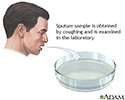Sputum Gram stain
Gram stain of sputum
A sputum Gram stain is a laboratory test used to detect bacteria in a sputum sample. Sputum is the material that comes up from your air passages when you cough very deeply.
The Gram stain method is one of the most commonly used methods to rapidly detect a bacterial infection, including pneumonia.
How the Test is Performed
A sputum sample is needed. You will be asked to cough deeply and spit any material that comes up from your lung into a special container.
- If this does not work, you may receive a breathing treatment before the test to help you cough more deeply.
-
If you have a dry cough or are unable to produce a sample, a
bronchoscopy
may be necessary.
Bronchoscopy
Bronchoscopy is a test to view the airways and diagnose lung disease. It may also be used during the treatment of some lung conditions.
 ImageRead Article Now Book Mark Article
ImageRead Article Now Book Mark Article
The sample is sent to a lab. The lab team member places a very thin layer of the sample onto a glass slide. This is called a smear. Stains are placed on the sample. The lab team member looks at the stained slide under a microscope, checking for bacteria and white blood cells. The color, size, and shape of the cells help identify the bacteria.
How to Prepare for the Test
No preparation is usually needed, unless a bronchoscopy is necessary.
Bronchoscopy
Bronchoscopy is a test to view the airways and diagnose lung disease. It may also be used during the treatment of some lung conditions.

How the Test Will Feel
How the test will feel depends on the method used to produce the sample. More discomfort is associated with a bronchoscopy.
Why the Test is Performed
Your doctor may order this test if you have a persistent or prolonged cough, or if you are coughing up material that has a foul odor or unusual color. The test may also be done if you have other signs and symptoms of respiratory disease or infection.
Normal Results
A normal result means that few to no white blood cells and no bacteria were seen in the sample. The sputum is clear, thin, and odorless.
Note: Normal value ranges may vary slightly among different laboratories. Talk to your doctor about the meaning of your specific test results.
What Abnormal Results Mean
An abnormal result means that bacteria is seen in the test sample. You may have a bacterial infection. A culture is needed to confirm the diagnosis.
RIsks
There are no risks associated with coughing up a sample. See the article on bronchoscopy for information regarding risks related to that procedure.
Bronchoscopy
Bronchoscopy is a test to view the airways and diagnose lung disease. It may also be used during the treatment of some lung conditions.

Considerations
The test may need to be repeated if the sample contains only saliva from the mouth.
References
Limper AH. Overview of pneumonia. In: Goldman L, Schafer AI, eds. Goldman's Cecil Medicine . 24th ed. Philadelphia, PA: Elsevier Saunders; 2011:chap 280.
-
Sputum test - illustration
A sputum sample is obtained by coughing deeply and expelling the material that comes from the lungs into a sterile cup. The sample is taken to a labarotory and placed in a medium under conditions that allow the organisms to grow. A positive culture may identify disease-producing organisms that may help diagnose bronchitis, tuberculosis, a lung abscess, or pneumonia.
Sputum test
illustration
-
Sputum test - illustration
A sputum sample is obtained by coughing deeply and expelling the material that comes from the lungs into a sterile cup. The sample is taken to a labarotory and placed in a medium under conditions that allow the organisms to grow. A positive culture may identify disease-producing organisms that may help diagnose bronchitis, tuberculosis, a lung abscess, or pneumonia.
Sputum test
illustration
Review Date: 11/24/2014
Reviewed By: Daniel Levy, MD, PhD, Infectious Diseases, Lutherville Personal Physicians, Lutherville, MD. Review provided by VeriMed Healthcare Network. Also reviewed by David Zieve, MD, MHA, Isla Ogilvie, PhD, and the A.D.A.M. Editorial team.

